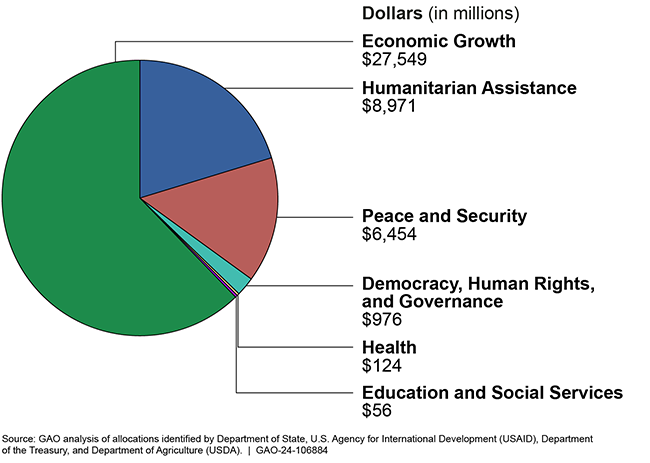Ukraine: Status of Foreign Assistance
Fast Facts
In response to the 2022 Russian invasion of Ukraine, four U.S. agencies have allocated $44.1 billion from supplemental funding and other funds to address the economic and humanitarian needs of people affected by the crisis.
This Q&A report examines the status of these funds and State's role in coordinating it.
State doesn't have a systematic, comprehensive approach to specifically track this funding. For example, State provided assistance to other countries affected by the crisis but didn't consistently include this assistance when tracking Ukraine-related funding.
We recommended that State better track funding related to the Ukraine crisis.
State, USAID, Treasury, and USDA Allocated $44.1 Billion in Response to the Crisis in Ukraine, as of Sept. 30, 2023 (dollars in millions)

Highlights
What GAO Found
Russia's February 2022 invasion of Ukraine has had devastating consequences: causing tremendous loss of life, creating a humanitarian crisis, threatening democracy, and exacerbating global challenges such as food insecurity. In response, Congress appropriated more than $113 billion under four Ukraine supplemental appropriations acts (Ukraine acts). From those appropriations, the Departments of State, the Treasury, Agriculture (USDA), and the U.S. Agency for International Development (USAID) identified $43 billion in foreign assistance as allocated in response to the crisis in Ukraine. In addition to the supplemental funding, State, Treasury, USDA, and USAID identified about $1.1 billion in other funding in response to the crisis in Ukraine. This combined $44.1 billion in foreign assistance was allocated largely for economic and humanitarian assistance. As of December 31, 2023, based on data that GAO compiled and assessed, State, USAID, Treasury, and USDA had obligated about $42.5 billion of this amount and disbursed about $33.8 billion of it.
GAO found that State was not using a systematic approach to categorize and separately track the status of foreign assistance specifically in response to the crisis in Ukraine. Consequently, State faced challenges in providing the status of this foreign assistance. Without such separate tracking, State cannot provide timely information on the status of foreign assistance related to the Ukraine crisis that can be used to understand the status of assistance and to inform decisions about future funding.
This foreign assistance generally falls into six categories:
- Economic Growth, such as financial support for the Ukrainian private sector;
- Humanitarian Assistance, such as food and shelter for internally displaced persons and refugees;
- Peace and Security, such as equipment for border police;
- Democracy, Human Rights, and Governance, such as strengthening public financial management practices;
- Health, such as addressing infectious disease outbreaks; and
- Education and Social Services, such as mental health programs for people affected by the war.
Why GAO Did This Study
Foreign assistance supports U.S. national interests and responds to humanitarian crises, among other things. This report focuses on foreign assistance funds—largely for civilians—allocated in response to the crisis in Ukraine, including for efforts associated with countries outside Ukraine that have also been affected by the crisis. This review does not cover funds allocated for other purposes or to other agencies, such as funding to the Department of Defense related to the Ukraine Security Assistance Initiative. Specifically, this report examines the status of the $44.1 billion in foreign assistance funding identified by State, Treasury, USDA, and USAID, as well as the types of activities this funding supports, in response to the crisis in Ukraine caused by the 2022 Russian invasion.
Division M of the Consolidated Appropriations Act, 2023, included a provision for GAO to conduct oversight of the assistance provided in the Ukraine acts. This report is part of a series of reviews that GAO has underway evaluating the types of U.S. assistance, including security assistance, being provided in response to the crisis in Ukraine. To determine the status of funding, we reviewed and assessed State, Treasury, USDA, and USAID financial information. To describe the types of assistance, we reviewed agency documentation and interviewed agency officials.
Recommendations
GAO is recommending that State implement improvements to financial systems to separately, more systematically, and comprehensively track the allocation, obligation, and disbursement of foreign assistance funding provided in response to the crisis in Ukraine. State concurred with the recommendation.
Recommendations for Executive Action
| Agency Affected | Recommendation | Status |
|---|---|---|
| Department of State |
Priority Rec.
The Secretary of State should ensure that the Director of the Office of Foreign Assistance and the Comptroller implement improvements to financial systems of record to separately, more systematically, and comprehensively track the allocation, obligation, and disbursement of foreign assistance funding provided in response to the crisis in Ukraine, to include base funds allocated to areas outside of Ukraine and exclude supplemental funds that were not allocated in response to the Ukraine crisis. (Recommendation 1) |
State concurred with our recommendation. As of March 2024, State was considering ways to automate and improve its tracking of foreign assistance in response to the crisis in Ukraine. For example, State is actively designing a custom financial report that should provide allocation, obligation, and expenditure data.
|
